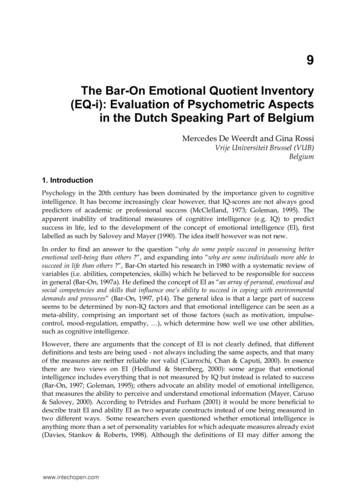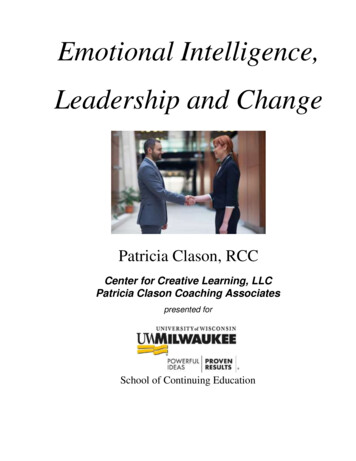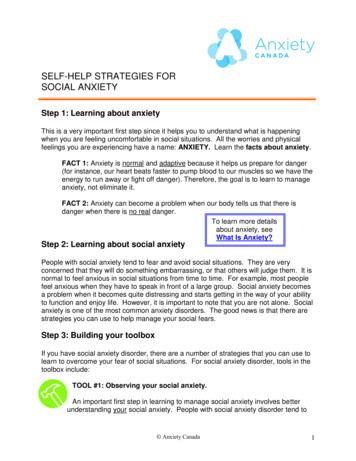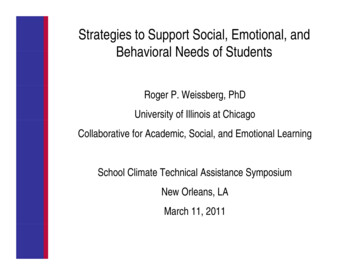
Transcription
Presenter’s ScriptsModule 22Social EmotionalTeaching StrategiesGail E. Joseph, Ph.D., University of Denver,Phil Strain, Ph.D., University of Colorado at DenverTweety Yates, Ph.D., & Mary Louise Hemmeter, Ph.D.University of Illinois at Urbana-ChampaignThe Center on the Social and EmotionalFoundations for Early LearningRev. 2/10Child CareBureauHead StartBureauThis material was developed by the Center on the Social and Emotional Foundations for Early Learning with federal funds from the U.S. Department of Healthand Human Services, Administration for Children and Families (Cooperative Agreement N. PHS 90YD0119). The contents of this publication do not necessarilyreflect the views or policies of the U.S. Department of Health and Human Services, nor does mention of trade names, commercial products, or organizationsimply endorsement by the U.S. Government. You may reproduce this material for training and information purposes. The authors wish to acknowledge Larry S.Joireman for the illustrations.
Module 2Social Emotional Teaching StrategiesLearner Objectives Participants will be able to discuss why it is important to be more intentional about teaching socialemotional skills. Participants will be able to identify strategies for supporting the development of friendship skills. Participants will be able to define emotional literacy and identify activities that build “feelingvocabularies.” Participants will understand the importance of providing opportunities for children to begin tounderstand their own, as well as others’ emotions. Participants will understand why children need to learn to control anger and handledisappointment and will be able to identify strategies to teach anger management skills. Participants will understand the importance of teaching problem solving and will be able to identifyproblem solving steps.Suggested AgendaRev. 2/10Time10 min.I.IntroductionII.Identifying the Importance of TeachingSocial Emotional Skills20 min.III.Developing Friendship Skills60 min.IV.Enhancing Emotional Literacy90 min.V.Identifying Feelings in Self and Others30 min.VI.Controlling Anger and Impulse30 min.VII.Developing Problem Solving Skills30 min.VIII.Pulling It All Together30 min.The Center on the Social and Emotional Foundations for Early LearningVanderbilt Universityvanderbilt.edu/csefelP 2.1
Module 2Social Emotional Teaching StrategiesMaterials Needed AgendaPowerpointChart Paper or White Board and MarkersVideo Clips 2.1Children Playing 2.2Play Organizing Skills 2.3Sharing Skills 2.4Being Helpful 2.5Giving Compliments 2.6Using Puppets 2.7Friendship Art 2.8Friendship Book 2.9Super Friend 2.10a Happy, Sad, Mad, & Scared Activity 2.10b Happy/Mad Activity 2.10c Using a Book to Discuss Emotions 2.11Hands are Not for Hitting 2.12 Glad Monster Sad Monster 2.13 Turtle Technique 2.14a Solution Kit Example 1 2.14b Solution Kit Example 2 Handouts 2.1Participants’ Powerpoint Slides 2.2Embedding Friendship Activity 2.3You’ve Got to Have Friends 2.4On Monday When it Rained Book Nook 2.5Book Activity 2.6Enhancing Emotional Vocabulary in Young Children 2.7Helping Young Children Control Anger and Handle Disappointment 2.8Pulling it All Together Activity 2.SE Session Evaluation FormRev. 2/10The Center on the Social and Emotional Foundations for Early LearningVanderbilt Universityvanderbilt.edu/csefelP 2.2
Module 2I. Introduction(10 minutes)12Social Emotional Teaching StrategiesI. Introduction (10 minutes)A. Introduce Module (Slide 1). Show Slide 2, the CSEFELTeaching Pyramid that was introduced in Module 1. Tellparticipants that we are now at the third level of thepyramid – social emotional teaching strategies. Remindparticipants that in Module 1 we talked about theimportance of building positive relationships anddesigning supportive environments (including rules,schedules, materials, and activities) to support children’ssocial emotional development and prevent challengingbehavior. In Module 2, we will continue to build on theseideas by discussing the use of effective strategies, ideas,and resources to help “teach” children social emotionalskills (friendship skills, emotional literacy, development ofempathy, impulse control, and problem solving).B. Show Slide 3 and go over the agenda with participants.34Rev. 2/10C. Review the learner objectives, shown on Slide 4, with theparticipants. Participants will be able to discuss why it is importantto be more intentional about teaching social emotionalskills. Participants will be able to identify strategies forsupporting the development of friendship skills. Participants will be able to define emotional literacyand identify activities that build “feeling vocabularies.” Participants will understand the importance ofproviding opportunities for children to begin tounderstand their own, as well as others’ emotions. Participants will understand why children need tolearn to control anger and handle disappointment andwill be able to identify strategies to teach angermanagement skills. Participants will understand the importance ofteaching problem solving and will be able to identifyproblem solving steps.The Center on the Social and Emotional Foundations for Early LearningVanderbilt Universityvanderbilt.edu/csefelP 2.3
Module 2II. Identifying theImportance of TeachingSocial EmotionalSkills: Why, When, Howand What(20 minutes)567Social Emotional Teaching StrategiesII. Identifying the Importance of Teaching SocialEmotional Skills: Why, When, How and What(20 minutes)A. Show Slide 5. Tell participants that there are severalthings that we want them to think about throughout thismodule: why it is important to be more intentional aboutteaching social emotional skills, when we should teach,and ideas and resources for how we can teach theseskills. The following slides address these areas:1. Show Slide 6 (social emotional development/skills foryoung children). Remind participants that they talkedabout these skills in Module 1. We now want them tothink about these skills in relation to the followingquestions:a. Ask participants why they think it is so important forus to “teach” children social emotional skills. Add totheir comments by sharing that these are some ofthe skills that we know that children need in order tobe more successful and to prevent challengingbehavior—not only in early care and educationsettings, but also in future educational settings.While we tend to be very thoughtful and intentionalabout teaching literacy, cognitive, and other skills,we need to be just as intentional about teachingsocial emotional skills.b. Show Slide 7. Ask participants what happens whenchildren don’t have these skills? Have them thinkabout children in their settings who don’t have theseskills. What have they noticed about these children?(Answers might include everything from specificchallenging behaviors to quiet and withdrawn). Howdo we help children learn these social emotionalskills? We “teach” them!8B. Show Slide 8 (Identifying Teachable Moments). Now thatwe have discussed why it is important to teach socialemotional skills, we are going to talk about “when” duringthe day we might teach these skills.1. Describe a typical situation that might happen in aclassroom or child care setting. For example, Trey isbuilding a castle in the block area. Blair comes to theRev. 2/10The Center on the Social and Emotional Foundations for Early LearningVanderbilt Universityvanderbilt.edu/csefelP 2.4
Module 2Social Emotional Teaching Strategiesblock area to play and decides that she needs theblock that is right in the middle of Trey’s castle. Blairgrabs the block, and Trey’s castle crumbles. Treyhits Blair and takes the block away. Blair startscrying (red arrow).2. Ask participants to generate ideas about whatteachers or child care providers might say to Treyand Blair at this point (e.g., “Use your words.”“Hitting is not okay.” “Say you’re sorry.” “Ask nicelyif you want something.” “Get an adult if you needhelp.” “Calm down.”).3. Point out that it is often at the crisis (red arrow)point that teachers try to teach new social skills.Discuss that while this is a teachable moment, andcan be a social skills lesson for Trey and Blair, thismight not be the most effective teachable momentbecause:a. The incident has already happened.b. Both children are upset.c. Blair may find the teacher reinforcing (“Wow, Imight do this again so I can get the teacher’sattention!”).4. Discuss effective teachable moments (referring tothe green arrows at the left-hand side). The mainpoint here is that we want to make sure that these“crisis moments” are not the only time that we are“teaching” social skills! Social skills can beembedded into almost any part of the dailyschedule—Intentional, planned times as well astaking advantage of naturally occurring momentsthroughout the day.9Rev. 2/10C. Display Slide 9. Remind participants that as we thinkabout “when” to teach social emotional skills, we alsoneed to consider stages of learning that should affect“how” we teach these skills:The Center on the Social and Emotional Foundations for Early LearningVanderbilt Universityvanderbilt.edu/csefelP 2.5
Module 2Social Emotional Teaching Strategies1. Acquisition – When children learn how to dosomething new, they acquire new skills or concepts.To support children’s acquisition of new skills, weneed to explain and demonstrate the skill/conceptand encourage children as they attempt to learn theskill. Skills can easily be lost at this stage – soencourage, encourage, encourage!2. Fluency – Once children acquire a new skill, theyneed to be able to use the skill proficiently orfluently. We need to provide multiple opportunitiesfor them to practice and master this skill/concept, aswell as prompt children to use their new skills innew situations.3. Maintenance – Once children are fluent with theirnew skills, they need to be able to use the skills (or“maintain” the skills) without support or promptingfrom an adult.4. Generalization – When children apply their newskills to new situations, people, activities, andsettings they demonstrate generalized use of theseskills. For example, a child might learn a new skill atchild care and then generalize that skill by using itat home (a different setting) or a child might learn anew skill with a grandparent and generalize it byusing it with their aunt (different people).5. Summarize by explaining to participants that eachlearning stage requires intentional, purposefulplanning on our part. This means that we need toplan “when” (during our daily schedule) we willteach new skills in order for children to haveopportunities to acquire new skills and to becomefluent with their new skills. But, we can’t stop at thatpoint! We also need to continue to planopportunities for children (and encourage them) topractice using their new skills throughout the daywithout “us” so they can show maintenance andgeneralization.Rev. 2/10The Center on the Social and Emotional Foundations for Early LearningVanderbilt Universityvanderbilt.edu/csefelP 2.6
Module 2Social Emotional Teaching StrategiesD. Being more aware of supporting learning also “tunes” usin to being purposeful and direct as well as not missingopportunities to encourage children when they arespontaneously learning and using their new skills. Wewant to take advantage of both planned and unplannedopportunities!E. Tell participants that we will now focus on the “what”and “how” to teach part. Highlight that we will spendthe rest of the day discussing teaching strategies andideas (“how”) for promoting friendship skills, emotionalliteracy skills, development of empathy, ideas forcontrolling anger and impulse, and problem solving skills(“what”).III. Friendship Skills(60 minutes)10III. Friendship Skills (60 minutes)A. What Behaviors Lead to Friendship Skills?1. Show Slide 10 and explain that we are now goingto talk about friendship skills. Have participantsthink about children who have lots of friends. Whathave they noticed about these children that makesit easier for them to make friends? Write responseson chart paper.11or(video clip 2.1)12Rev. 2/10a. Show Slide 11/Video Clip 2.1. Ask participants towatch the three children playing at center timeshown in Video Clip 2.1. What helped the childrenbe successful or unsuccessful playing together asfriends? Discuss observations and add to the list onthe chart paper. To play video double click on thephotograph on the slide. To advance to the nextslide, click the down arrow on your keyboard.b. Show Slide 12. Discuss that when children aresuccessful at making friends, they haveopportunities to learn and practice many social skillssuch as cooperation, sharing, turn taking, problemsolving, and conflict resolution. Explain that thereare several discrete behaviors that young childrenengage in during play with each other that seem tobe directly related to having friends (Tremblay et al.,1981). That is, children who do more of thesebehaviors are more likely to have friends. Thesespecific behaviors are described in more detailbelow. Explain that several of the slides have videoThe Center on the Social and Emotional Foundations for Early LearningVanderbilt Universityvanderbilt.edu/csefelP 2.7
Module 2Social Emotional Teaching Strategiesexamples. Share with participants that the twochildren that they will see in Video clips 2.2 (playorganizers), 2.3 (sharing), and 2.4 (being helpful)did not know each other before they were videotaped playing together. This is significant becauseit demonstrates that when children have theseskills, it makes it easier for them to have morepositive experiences in playing together andmaking new friends. (Note to presenter: each slideis organized around five areas: rationale,descriptions, demonstrations, practice, andpromotion opportunities).131) Play Organizers. Show Slide 13 and brieflydiscuss the following:a) Rationale – Children who are able toorganize play situations can create playopportunities for themselves and others.b) Describe the skill – Play organizers might tryto get a friend’s attention, give a friend a toy,or give an idea of what they might do with atoy or material. With preschoolers, playorganizers are usually “Let’s” statements,such as, “Let’s play trucks.” Often these“Let’s” statements are followed bysuggestions about roles (e.g., “You be thedriver and I’ll put the logs on the truck”) orspecific activities (e.g., “Roll it to me.”).c) Demonstrate – Discuss how you can buildchildren’s play organizing skills bydemonstrating or role playing “right” and“wrong” ways to organize play situationswhen you want other children to play withyou.d) Practice – Remind participants about thestages of learning that we discussed earlier.It is really important for us to provideopportunities for children to practice playorganizing. As mentioned above, we mighthave children role play or we can join intheir play and model ways to organize playsituations.Rev. 2/10The Center on the Social and Emotional Foundations for Early LearningVanderbilt Universityvanderbilt.edu/csefelP 2.8
Module 2Social Emotional Teaching Strategiese) Promote – Discuss how we need to makesure that we are not only providingopportunities for children to practice theseskills, but that we are also promoting,supporting, and encouraging children asthey “try out” their new skills.f) Show Slide 14/Video Clip 2.2 as anexample of play organizing skills. Theseare the two children mentioned above whohad never met each other before this playsession.14or(video clip 2.2)2) Sharing. Show Slide 15 and briefly discussthe following:15a) Rationale – Children who are able to sharetoys and materials often have more positiveexperiences interacting with peers. In turn,since having this skill allows themopportunities to practice and experiencepositive social interactions, they also beginto learn how to better handle situationswhen they don’t want to share what theyare playing with. As adults, we often expectyoung children to share without helpingthem understand what it means to do so(Kemple, 2004).b) Describe the skill – Sharing takes manyforms among preschoolers. Children mightoffer to share materials they are playingwith, respond to requests from otherchildren to share (“Can I have some of yourpaint?”), ask others to share what they areplaying with as well as refuse to share whatthey are playing with.c) Demonstrate – Discuss how you can buildchildren’s “sharing” skills by demonstratingor role playing ways to share toys andmaterials as well as ways to respond torequests from other children to share. It isalso important to discuss (and include indemonstrations/role plays) that sometimesthey might not want to share what they areRev. 2/10The Center on the Social and Emotional Foundations for Early LearningVanderbilt Universityvanderbilt.edu/csefelP 2.9
Module 2Social Emotional Teaching Strategiesplaying with and that is okay. Discuss whatthe children might say or do in thosesituations.d) Practice – Again, it is really important for usto provide opportunities for children topractice sharing, in direct and indirectteaching situations. For example, beforechildren leave large group ask them whatthey might share during center time andwho they might share with, or set up anactivity where children can work togetherand share materials.e) Promote – Promote, support, andencourage children as they share. Whenyou see children sharing—comment. Have a“sharing” day where everyone (includingadults) tries really hard to share all day!Discuss ahead of time the ways thatchildren might share across the differentparts of the daily schedule.16f) Show Slide 16/Video Clip 2.3 as anexample of sharing.or3) Being Helpful/Team Players. Show Slide 17and briefly discuss the following:(video clip 2.3)17a) Rationale – Being helpful or a team player isanother skill that makes it easier for childrento play and respond to others.b) Describe the skill – Being helpful orassisting others takes many forms at thepreschool level. Children might help eachother onto or off of an apparatus, they cantell or show a friend how to do something;or they can assist someone in distress.c) Demonstrate – Demonstrate and role playwhat it means to be helpful to others. Usepuppets to demonstrate situations whereone puppet needs help or is upset and havethe other puppet respond in appropriate,helpful ways. Also demonstrate or role playRev. 2/10The Center on the Social and Emotional Foundations for Early LearningVanderbilt Universityvanderbilt.edu/csefelP 2.10
Module 2Social Emotional Teaching Strategiessituations where a child or puppet doesn’trespond and discuss how that might makethe other child feel.d) Practice – Role playing, as mentionedabove, is a great way for children topractice being helpful. Adults can also setup situations and ask for help so childrenhave opportunities to respond. Duringgroup time, situations can be read or actedout and children can hold up a smiley facefor helpful behavior or a frown for unhelpfulbehavior. Small group activities can also beplanned where children need to help eachother in order to complete a task.e) Promote – Promote, support, andencourage children when they are beinghelpful or responding to another child in astressful situation.f) Show Slide 18/Video Clip 2.4 as anexample of children being helpful.4) Taking Turns. Show Slide 19 and brieflydiscuss the following:18or(video clip 2.4)19a) Rationale – In addition to engaging in thebehaviors listed above, the formation offriendship is equally dependent upon twopatterns of interaction:1) First, it is necessary for children to bereciprocal in their interactions (eachhas a turn). Reciprocity has twodimensions. Initially, children need to beresponsive to the social bids/requestsof others. Also, over a period of time(say several months), it is importantthat there be a relatively equal numberof occasions that each member of afriendship dyad starts an interaction.2) In addition to reciprocity, friendshippatterns of interaction are alsocharacterized by the length ofRev. 2/10The Center on the Social and Emotional Foundations for Early LearningVanderbilt Universityvanderbilt.edu/csefelP 2.11
Module 2Social Emotional Teaching Strategiesinteraction occurrences. That is,friendship pairs engage in graduallylonger play episodes and interactions.b) Describe the skill – Turn-taking mightinvolve children playing a game where “youtake a turn, I take a turn”, they might askfor their turn with a toy, they might get afriend’s attention to initiate play by looking,tapping, or calling them, or holding out theirhand to indicate initiation of play and turntaking.c) Demonstrate – Once again, demonstrationsand role playing to show ways to initiateplay and turn taking are very effective.d) Practice – Teaching children games (boardgames, games with balls, etc.) is a greatway to support development of turn takingskills. Planning activities where each childhas to take a turn to complete the task alsoallows for practice.e) Promote – Promote, support, andencourage children as they initiate play andengage in turn taking.205) Giving Compliments. Show Slide 20 andbriefly discuss the following:a) Rationale – Although these behaviors donot often occur among preschoolers, theytend to have a powerful effect on theformation of friendships.b) Describe – Preschoolers compliment oneanother’s successes, buildings, andappearances. They might say, “Good jobJuan,” “He’s a smart boy,” “I like the wayyou painted that picture of your house.”Rev. 2/10The Center on the Social and Emotional Foundations for Early LearningVanderbilt Universityvanderbilt.edu/csefelP 2.12
Module 2Social Emotional Teaching Strategiesc) Demonstrate – When adults givecompliments, it sets up an atmosphere inthe classroom that promotes complimentingeach other. This can be a great model forchildren. Demonstrations and role playingcan also help children learn whatcompliments are and what words theymight use to compliment someone.d) Practice – Role playing and having acompliment circle where children cancompliment each other about somethingthat they did during the day allows childrenopportunities to practice usingcompliments.e) Promote – Promote, support, andencourage children as they complimenteach other.21f) Show Slide 21/Video Clip 2.5 (GivingCompliments). This is a great example ofwhat happens when the adults in aclassroom give compliments - childrenbegin to give compliments also!or(video clip 2.5)226) Knowing When and How to Give Apologies.Show Slide 22 and briefly discuss thefollowing:a) Rationale – Learning when and how to giveapologies, just like learning how to givecompliments, can have positive effects onthe formation of friendships. Children beginto learn how to pay attention and be moreresponsive to their friends’ feelings as wellas how their behavior affects others.b) Describe – Children might say, “I’m sorry Ihit you when you took my ball,” or “I didn’tmean to push you.”c) Demonstrate – Demonstrating and roleplaying are great ways to help childrenlearn what it means to give an apology.Use puppets to demonstrate apologies.Rev. 2/10The Center on the Social and Emotional Foundations for Early LearningVanderbilt Universityvanderbilt.edu/csefelP 2.13
Module 2Social Emotional Teaching Strategiesd) Practice – Role play different situations andlet children try to figure out what they mightsay to apologize. Have children make up astory in which the characters need toapologize for something.e) Promote – Promote, support, andencourage children as you hear themapologizing.23B. Setting the Stage for Friendship (Show Slide 23).1. Prior to “teaching” friendship skills, adult caregiversneed to set the stage by including the following fiveelements in their early childhood settings (e.g.,Head Start, Child Care, Family Day Care home):a. An inclusive environment where all children aremeaningfully included in natural proportions iscritical to setting the stage for friendships(Guralnick, 1990).b. Having cooperative use toys and materialsincreases the opportunities for social interaction.Cooperative use toys are those that naturally lendthemselves to two or more children playingtogether. Some examples of cooperative use toysare balls, puppets, wagons, two telephones,dramatic play materials, rocking boats, and boardgames.c. Examine daily routines and embed friendship andsocial interaction instruction and practiceopportunities throughout the day (refer back tothe stages of learning discussed earlier).d. In order to ensure that friendship and socialinteraction instruction gets the necessaryattention, teachers and caregivers need to includerelated goals and objectives on a child’sIEP/IFSP. Although these goals are likely to bethe most critical for the child’s later development,they often do not appear on IEPs or IFSPs(McConnell, McEvoy, & Odom, 1992), perhapsbecause many assessments do not include theseskills as test items.Rev. 2/10The Center on the Social and Emotional Foundations for Early LearningVanderbilt Universityvanderbilt.edu/csefelP 2.14
Module 2Social Emotional Teaching Strategiese. Most importantly, teachers and caregivers need todevote energy toward creating an atmosphere offriendship. When you walk into a classroom, childcare, or home day care setting where an adulthas successfully created this climate, you seeadults giving time and attention to children whenthey engage in friendly behaviors, you hear adultstalking nicely to one another, and you hearchildren supporting one another’s friendlybehavior. Overall, you get a sense that friendshipis the ultimate goal. Ask participants what elsethey can do to promote this atmosphere offriendship.24C. Strategies for Developing Friendship Skills. (ShowSlide 24).1. Setting the stage is a necessary step in supportingchildren’s developing friendships and teaching thecritical skills described above. There are severalways to teach children these skills: teaching theconcept, modeling appropriate behavior, providingpractice opportunities with feedback, and supportingchildren’s use of the behavior in context. Discussthe following strategies:a. Modeling. Modeling can include adults or peersdemonstrating the friendship skill or video basedmodeling with short vignettes of childrenengaging in friendly behavior (Webster-Stratton &Hammond, 1997). Often, it is effective to modelboth examples and non-examples followed byopportunities for correct responding. There arethree guiding principles of effective role-playmodeling strategies:1) Use invisible support, that is, call on the childwho you are confident will model the skillappropriately before calling on a child who willneed more support.2) Sometimes when children are modeling thefriendship skill in front of their peers, they canget carried away with being silly orinappropriate. It is important to give childrenanother chance and more support so that theyRev. 2/10The Center on the Social and Emotional Foundations for Early LearningVanderbilt Universityvanderbilt.edu/csefelP 2.15
Module 2Social Emotional Teaching Strategiesare successful in demonstrating the skillappropriately. This approach allows them toreceive encouragement from the teacher andother children for doing the skill.3) Because role-plays typically involve only oneor two children at a time, it is necessary toplan ways for the rest of the children to beactively engaged. Strategies for includingchildren who are not involved in the role-playinclude having them give a thumbs up forfriendly behavior and a thumbs down forunfriendly behavior; patting themselves on theback if this is a behavior they do; clappingwhen the role-play is over; saying “ready, set,action” before the role-play begins; or having aPopsicle stick sign with a happy face on oneside and a sad face on the other (childrenshow the happy face when the behavior beingmodeled is friendly and the sad face when thebehavior being modeled is unfriendly). It isalso important to keep track of who has had achance to role-play and ensure that all of thechildren in the class get a turn during theweek.4) Whenever possible, using small groups toteach these skills will be useful in terms ofgiving all children opportunities for practice.b. Modeling with Video. The use of video to helpmodel friendship skills can be very effective withyoung children. Video-based modeling isparticularly effective for several reasons:1) Videos can capture real-life examples ofchildren using friendly behavior. Theseexamples can be used to generate discussionabout the friendly behavior and the context inwhich it is used in the video. Video vignettescan also display non-examples. Thesevignettes can be used to teach children todiscriminate between friendly and unfriendlybehavior and prompt children to develop andshare alternative behaviors and solutions ifinitial ideas are not effective.Rev. 2/10The Center on the Social and Emotional Foundations for Early LearningVanderbilt Universityvanderbilt.edu/csefelP 2.16
Module 2Social Emotional Teaching Strategies2) Video clips can be paused, and children canbe prompted to attend to the salient featuresof the friendly behaviors and the context inwhich they occur. Children can also makepredictions about “what will happen next”when the child featured in the video uses afriendly or unfriendly behavior.3) Children love watching videos, which makesthis format particularly powerful in engagingand keeping children’s attention.c. Modeling with Puppets. Similar to videos,puppets are very engaging to young children:1) Because adults are in control of the puppet,the puppet can always be a responsive playpartner. The puppet can model friendly playand, when appropriate and planned, canmodel non-examples. Puppets in the image ofchildren are particularly effective because theyprovide a proximate model. That is, childrenare more likely to emulate the behavior ofmodels that look like themselves. But, anypuppet will work!2) Additionally, some children will disclose moreabout
Rev. 2/10 The Center on the Social and Emotional Foundations for Early Learning Vanderbilt University vanderbilt.edu/csefel P 2.1 Learner Objectives Suggested Agenda Participants will be able to discuss why it is important to be more intentional about teaching social emotional skills. Participants will be able to identify strate










